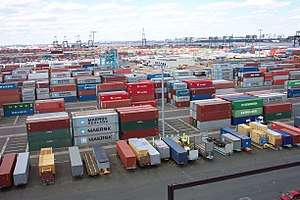Drayage
Drayage is the transport of goods over a short distance in the shipping and logistics industries.[1][2] Drayage is often part of a longer overall move, such as from a ship to a warehouse. Some research defines it specifically as "a truck pickup from or delivery to a seaport, border point, inland port, or intermodal terminal with both the trip origin and destination in the same urban area".[3] Port drayage is the term used when describing[4] short hauls from ports and other areas to nearby locations. Drayage is a key aspect of the transfer of shipments to and from other means of transportation. The term drayage is also used for the fee paid for such services.

History
The term originally meant "to transport by a sideless cart", or dray. Such carts, pulled by dray horses, were used to move goods short distances, limited by the physical limitations of a dray horse. Dray activities generally occurred at marine ports, spreading to canal and rail terminals. Over time, the dray horse was replaced by the delivery truck.
The study of drayage is a relatively new area, as recent events have elevated the prominence of the dray industry. Economically, NAFTA and the growth of globalized trade have dramatically increased imports and exports that are shipped in marine shipping containers. Furthermore, the rise in fuel costs have limited the options for cost-cutting along the supply chain. Although drayage is a very small component (both in terms of time and distance) of the supply chain, its cost and potential problems can be disproportionately high.
Various interest groups began realizing the influence of drayage. For example, environmentalists sought to reduce harbor trucking pollution by regulating dray activities. Shocked by the spike in fuel prices, businesses became more aware of the costs of port congestion and regulations concerning driver hours of service. Public safety advocates worried that dray trucks, which use city streets during normal working hours, were "under-regulated and a risk to commuters". Lastly, organized labor was concerned about the bargaining power of the trucking industry, as dray drivers were purported to be "low bid carriers".[3]
In intermodal freight transport, drayage is the transport of containerized cargo by specialized trucking companies between ocean ports or rail ramps and shipping docks.[5][6] Once the cargo is loaded into a container, it isn’t touched again until it reaches its destination.[7]
References
- "Drayage – What is Drayage?". Dedola Global Logistics. 2012-01-25. Retrieved 2017-05-07.
- "What is Drayage? | CCC Transportation, LLC". www.ccctrans.com. Retrieved 2017-05-07.
- Harrison, Robert; Nathan Hutson; Jolanda Prozzi; Juan Gonzalez; John McCray; Jason West (February 2009). "The Impacts of Port, Rail, and Border Drayage Activity in Texas" (PDF). Center for Transportation Research, the University of Texas at Austin. p. 2. Retrieved 19 March 2012.
- "What is Drayage?". globalforwarding.com. Retrieved 2017-04-21.
- Bloomberg.com: Financial Glossary
- Advances At CSX Intermodal – Forbes.com
- "Detroit, Michigan Intermodal Transport and Drayage | Courtesy Transfer Inc". Courtesy Transfer Inc. Retrieved 2018-02-25.
| Look up drayage in Wiktionary, the free dictionary. |